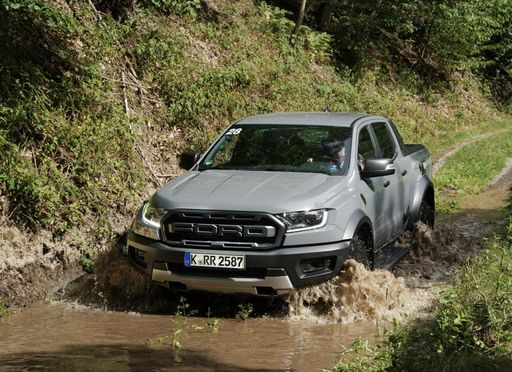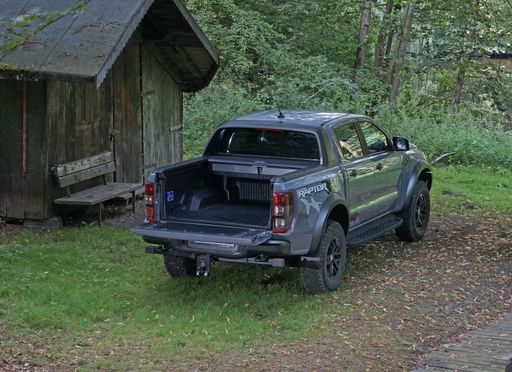When it comes to rugged pickup trucks, two names frequently stand out: the Ford Ranger and the Isuzu D-Max. Both vehicles offer robust capabilities, innovative features, and a reputation for enduring performance. However, they cater to different preferences and needs within the truck segment. This article dives into the technical aspects and innovations of these two popular models to help potential buyers make an informed choice.
Ford Ranger vs Isuzu D-Max – Performance, range & efficiency compared
Everyday use, family trips or long-distance drives – here’s where the differences show.
Discover whether Ford Ranger or Isuzu D-Max fits your lifestyle better.
Design and Dimensions
From a design perspective, both the Ford Ranger and Isuzu D-Max showcase a muscular appearance typical of modern pickups. The Ranger measures approximately 5370 mm in length, 1918 mm in width, and stands at a height of 1884 mm. In contrast, the D-Max is slightly shorter, measuring around 5310 mm in length, 1810 mm in width, and 1770 mm in height. This variance in dimensions might affect maneuverability and load capacity, depending on user requirements.
Engine Performance and Efficiency
The Ford Ranger offers several engine options, including diesel and petrol varieties, with power outputs ranging from 170 HP to a commanding 292 HP. This diverse range allows consumers to select a model tailored to their performance expectations. On the other hand, the Isuzu D-Max features a single diesel engine producing a maximum of 163 HP. While the D-Max provides respectable power, the Ranger's superior horsepower options cater to those needing more robust towing and hauling performance.
In terms of fuel efficiency, the Ranger's consumption ranges from 8.4 to 10.6 L/100km, while the D-Max sits at a slightly more economical 8.1 to 9.2 L/100km. Though the D-Max generally offers better fuel economy, this trade-off must be weighed against the higher performance potential of the Ranger.
Transmission and Drive Type
Both vehicles come equipped with a choice of manual or automatic transmissions. The Ford Ranger features an all-wheel-drive system that enhances traction and stability in variable terrains, making it ideal for adventurous drivers. In contrast, the D-Max offers both rear-wheel drive and all-wheel drive options, allowing buyers to select a configuration that best suits their driving habits and usage scenarios.
Acceleration and Speed
The Ford Ranger displays impressive acceleration figures, with some variants reaching 0-100 km/h in as little as 7.9 seconds. Conversely, the D-Max, with an acceleration time of 12.6 seconds, lags behind the Ranger in this aspect. However, both trucks share a top speed of 180 km/h, indicating that they are suitable for both highway cruising and off-road adventures.
Payload Capacity and Practicality
When it comes to load-carrying capacity, the D-Max takes the edge with a payload configuration reaching up to 1130 kg in some variants, compared to the Ranger's maximum payload of 1108 kg. This aspect makes the D-Max a solid choice for users looking for maximum hauling capabilities.
Innovative Features
Innovation plays a crucial role in the modern pickup segment. The Ford Ranger is equipped with advanced safety features, including adaptive cruise control, lane-keeping assist, and a comprehensive infotainment system featuring Ford's SYNC technology. These options enhance safety and connectivity for drivers and passengers alike.
On the other hand, the Isuzu D-Max emphasizes reliability and ruggedness within its design, incorporating essential features like advanced braking systems and a robust chassis that endures tough conditions. While it may not boast the same level of high-tech gadgets as the Ranger, it appeals to those who prioritize durability over extravagance.
Conclusion
Choosing between the Ford Ranger and Isuzu D-Max ultimately depends on your needs and preferences. If you seek a vehicle with a range of powerful engine options, cutting-edge technology, and superior performance metrics, the Ranger is an excellent choice. However, if your priority is a dependable workhorse with impressive payload capacity and effective fuel efficiency, the D-Max shines brightly. Both vehicles have their strengths, making them worthy contenders in the competitive pickup market.
Here’s where it gets real: The technical differences in detail
Costs and Efficiency:
Price and efficiency are key factors when choosing a car – and this is often where the real differences emerge.
Isuzu D-Max has a minimal advantage in terms of price – it starts at 34300 £, while the Ford Ranger costs 37500 £. That’s a price difference of around 3248 £.
Fuel consumption also shows a difference: Ford Ranger manages with 3.10 L and is therefore convincingly more efficient than the Isuzu D-Max with 8.70 L. The difference is about 5.60 L per 100 km.
Engine and Performance:
Power, torque and acceleration are the classic benchmarks for car enthusiasts – and here, some clear differences start to show.
When it comes to engine power, the Ford Ranger has a significantly edge – offering 292 HP compared to 163 HP. That’s roughly 129 HP more horsepower.
In acceleration from 0 to 100 km/h, the Ford Ranger is significantly quicker – completing the sprint in 7.90 s, while the Isuzu D-Max takes 12.60 s. That’s about 4.70 s faster.
In terms of top speed, the Ford Ranger performs barely noticeable better – reaching 190 km/h, while the Isuzu D-Max tops out at 180 km/h. The difference is around 10 km/h.
There’s also a difference in torque: Ford Ranger pulls decisively stronger with 697 Nm compared to 360 Nm. That’s about 337 Nm difference.
Space and Everyday Use:
Whether family car or daily driver – which one offers more room, flexibility and comfort?
Both vehicles offer seating for 5 people.
In curb weight, Isuzu D-Max is minimal lighter – 1905 kg compared to 2082 kg. The difference is around 177 kg.
When it comes to payload, Ford Ranger slight takes the win – 1108 kg compared to 1095 kg. That’s a difference of about 13 kg.
Who wins the race?
The Ford Ranger proves to be dominates this comparison and therefore becomes our DriveDuel Champion!
Ford Ranger is the better all-rounder in this comparison.
 @ Ford Motor Company / Ford Media Center
@ Ford Motor Company / Ford Media Center
Ford Ranger
Ford Ranger
The Ford Ranger stands out in the pickup market with its robust build and versatile capabilities, making it a popular choice for both work and leisure. Its modern design is complemented by a well-equipped interior, providing comfort and advanced technology. Whether tackling challenging terrains or cruising through the city, the Ranger delivers a reliable and dynamic driving experience.
details @ Ford Motor Company / Ford Media Center
@ Ford Motor Company / Ford Media Center
 @ Ford Motor Company / Ford Media Center
@ Ford Motor Company / Ford Media Center
Isuzu D-Max
The Isuzu D-Max stands out in the pickup truck market with its robust design and impressive durability, making it a reliable choice for both work and leisure. Its interior blends practicality with a touch of comfort, featuring user-friendly technology that enhances the driving experience. This vehicle's off-road capabilities and strong performance make it a versatile companion for tackling a variety of terrains.
details
 @ Ford Motor Company / Ford Media Center
@ Ford Motor Company / Ford Media Center
|
|
|
|
|
Costs and Consumption |
|
|---|---|
|
Price
37500 - 71900 £
|
Price
34300 - 50100 £
|
|
Consumption L/100km
3.1 - 13.8 L
|
Consumption L/100km
8.7 - 9 L
|
|
Consumption kWh/100km
-
|
Consumption kWh/100km
-
|
|
Electric Range
42 km
|
Electric Range
-
|
|
Battery Capacity
11.80 kWh
|
Battery Capacity
-
|
|
co2
70 - 315 g/km
|
co2
228 - 235 g/km
|
|
Fuel tank capacity
80 L
|
Fuel tank capacity
76 L
|
Dimensions and Body |
|
|---|---|
|
Body Type
Pickup
|
Body Type
Pickup
|
|
Seats
2 - 5
|
Seats
2 - 5
|
|
Doors
2 - 4
|
Doors
2 - 4
|
|
Curb weight
2082 - 2511 kg
|
Curb weight
1905 - 2110 kg
|
|
Trunk capacity
-
|
Trunk capacity
-
|
|
Length
5370 - 5420 mm
|
Length
5280 - 5320 mm
|
|
Width
1918 - 1968 mm
|
Width
1810 - 1870 mm
|
|
Height
1868 - 1922 mm
|
Height
1770 - 1790 mm
|
|
Max trunk capacity
-
|
Max trunk capacity
-
|
|
Payload
676 - 1108 kg
|
Payload
990 - 1095 kg
|
Engine and Performance |
|
|---|---|
|
Engine Type
Diesel, Petrol, Plugin Hybrid
|
Engine Type
Diesel
|
|
Transmission
Manuel, Automatic
|
Transmission
Automatic
|
|
Transmission Detail
Manual Gearbox, Automatic Gearbox
|
Transmission Detail
Automatic Gearbox
|
|
Drive Type
All-Wheel Drive
|
Drive Type
All-Wheel Drive
|
|
Power HP
170 - 292 HP
|
Power HP
163 HP
|
|
Acceleration 0-100km/h
7.9 - 12.1 s
|
Acceleration 0-100km/h
12.60 s
|
|
Max Speed
180 - 190 km/h
|
Max Speed
180 km/h
|
|
Torque
405 - 697 Nm
|
Torque
360 Nm
|
|
Number of Cylinders
4 - 6
|
Number of Cylinders
4
|
|
Power kW
125 - 215 kW
|
Power kW
120 kW
|
|
Engine capacity
1996 - 2993 cm3
|
Engine capacity
1898 cm3
|
General |
|
|---|---|
|
Model Year
2022 - 2025
|
Model Year
2024 - 2025
|
|
CO2 Efficiency Class
G, B
|
CO2 Efficiency Class
G
|
|
Brand
Ford
|
Brand
Isuzu
|
What drive types are available for the Ford Ranger?
The Ford Ranger is offered with All-Wheel Drive.
The prices and data displayed are estimates based on German list prices and may vary by country. This information is not legally binding.
